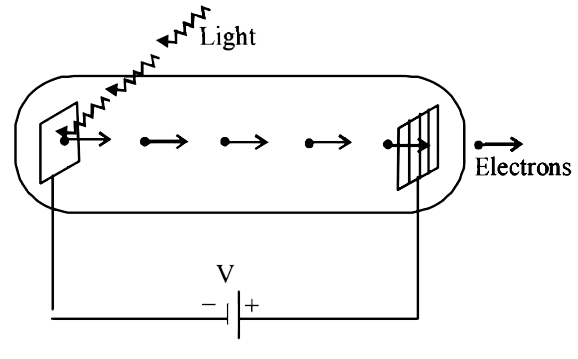Light of wavelength λphfalls on a cathode plate inside a vacuum tube as shown in the figure .The work function of the cathode surface is ϕ and the anode is a wire mesh of conducting material kept at distance d from the cathode. A potential different V is maintained between the electrodes. If the minimum de Broglie wavelength of the electrons passing through the anode is λe which of the following statement (s) is (are) true?

λe decreases with increases in ϕandλph
λe is approximately halved if d is doubled
For large potential difference (V>>ϕ/e),λe is approximately halved if V is made four times
λe increases at the same rate as λph for λph<hc/ϕ
The correct Answer is:C
Let m be the mass of electron and v be the speed of electron when it reaches anode. The de Broglie wavelength of electron can be written as follows :
λe=hmv⇒m2v2=h2λ2e⇒12mv2=h22mλ2e
⇒ K.E. of electron on reaching anode =h22mλ2e ....(i)
Kinetic energy of electron when emitted from cathode
=hcλph−ϕ
K.E. is further increased due to work done by electric field.
⇒ K.E. of electron , on reaching anode
=hcλph−ϕ+eV ...(ii)
From (i) and (ii), we can write the following :
h22mλ2e=hcλph−ϕ+eV ....(iii)
From (iii) ,we can see that when ϕandλph are increased then λe also increases , hence option (a) wrong .
From (iii) we can see that λe is independent of d, hence option (b) is wrong . When V is very large then h22mλ2e≈eV , hence when V is made 4 times, then λe is approximately halved. So option (c) is correct.
From equation (iii) , we can understand that option (d) cannot be correct, hence only option (c) is correct in this equation.
Topper's Solved these Questions
- BOOK - MODERN PUBLICATIONCHAPTER - DUAL NATURE OF RADIATION AND MATTER EXERCISE - COMPETITION FILE (OBJECTIVE TYPE QUESTIONS ( C - Multiple Choice Questions) )8videos
DUAL NATURE OF RADIATION AND MATTER
- BOOK - MODERN PUBLICATIONCHAPTER - DUAL NATURE OF RADIATION AND MATTER EXERCISE - COMPETITION FILE (OBJECTIVE TYPE QUESTIONS ( D - Multiple Choice Questions) )5videos
DUAL NATURE OF RADIATION AND MATTER
- BOOK - MODERN PUBLICATIONCHAPTER - DUAL NATURE OF RADIATION AND MATTER EXERCISE - COMPETITION FILE (OBJECTIVE TYPE QUESTIONS ( B - Multiple Choice Questions) (JEE (Main) & Other State Boards for Engineering entrance))18videos
DUAL NATURE OF RADIATION AND MATTER
- BOOK - MODERN PUBLICATIONCHAPTER - CURRENT ELECTRICITYEXERCISE - Chapter Practice Test15videos
CURRENT ELECTRICITY
- BOOK - MODERN PUBLICATIONCHAPTER - ELECTRIC CHARGES AND FIELDS EXERCISE - Chapter Practice Test15videos
ELECTRIC CHARGES AND FIELDS
Similar Questions
Knowledge Check
- Question 1 - Select One
Light of wavelength λphfalls on a plate a vacum teke as shown in the figure .The work function of the conducting meterial kept at a distance d from the cathon A petential different V is maximum between the electrodes if the minimum de Brogle waveleeength of the electrons passing through the anode is λe which of the following statement (s) is (are) true?
 Aλedecrease with increase in ϕandλphBλe is approximentily balved , if d is doubledCfor large potential diffrence (V>>ϕ/e).Λeis approximately halved if V is made four timeDλe increase at the same rate as λphforλph<hc/ϕ
Aλedecrease with increase in ϕandλphBλe is approximentily balved , if d is doubledCfor large potential diffrence (V>>ϕ/e).Λeis approximately halved if V is made four timeDλe increase at the same rate as λphforλph<hc/ϕ - Question 2 - Select One
de-Broglie wavelength λ is
Aproportional to massBproportional to impulseCinversely proportional to impulseDindependent to impulse - Question 3 - Select One
If the potential difference between the anode and cathode of the X-ray tube is increases
 AThe peaks at R and S would move to shorter wavelengthBThe peaks at R and S would remain at the same wavelengthCThe cut off wavelength at P would decreaseD(b) and (c) both are correct
AThe peaks at R and S would move to shorter wavelengthBThe peaks at R and S would remain at the same wavelengthCThe cut off wavelength at P would decreaseD(b) and (c) both are correct
The potential difference between the cathode. And the target electrod in a coolidge tube is 24.75 kV. The minimum wavelength of the emitted X-rays is
View SolutionThe potential difference between the cathode and the target in a Collidge tube is 100 kV . The minimum wavelength of the X-rays emitted by the tube is
View SolutionA proton and an electron are accelerated by the same potential difference, let λe and λp denote the de-Broglie wavelengths of the electron and the proton respectively
View SolutionThe de-Broglie wavelength of an electron, an α-particle and a proton are λe,λa,λp. Which is wrong from the following?
View SolutionIf the cathode-anode potential difference in an X-ray tube be 10 V then the maximum energy of X-ray photon can be
View Solution

